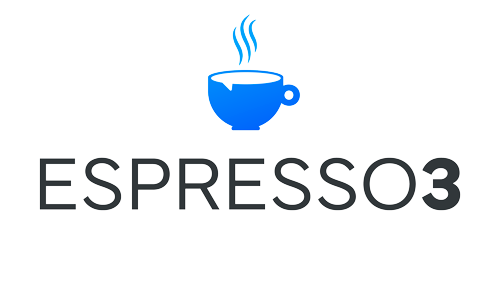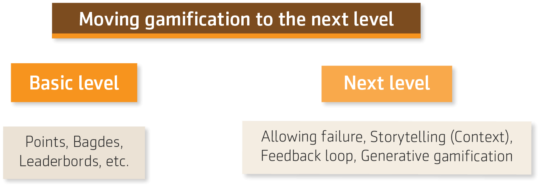Hi, I am here with Karl Kapp, and we will talk about moving gamification to the next level. I am Wagner Cassimiro and this is the Espresso3.
Karl, what are the elements that we can put gamification to the next level?
Right now that are a lot of gamification efforts are really focused on points, badges and leaderboards, kind of basic game elements, not elements that engage learners a whole lot. So, if we really want to move gamification to the next level we need to look at things like allowing failure, freedom to fail.
Games are great at allowing you to fail in a safe and comfortable environment and then encouraging you to try again, to do it again. So the first thing we need to think about it is allowing failure to happen in gamification.
The second thing that I think really needs to happen is the context or the storytelling. In organizations, we need to do things, but we need to do things in context. We need to know why we are doing it, why this makes sense. So, storytelling is a really good way to do that, and so I think that needs to be implemented into the next level of gamification.
The third thing, I think, it is called the feedback loop. So, when you do something you need to get a feedback on whether or not you did it correctly or incorrectly and then you need to make adjustments and then you need to get feedback again, and make adjustments, and get feedback again. So that’s a really important element. Feedback loops are something that we don’t often talk about. We talk about gamification, but that is a really important element to add in there.
And then the fourth level, which I think it’s really kind of exciting and hasn’t happened a lot it’s what I call generative gamification. So, a lot of times gamification efforts are focused on what the company already knows and want you to know. There is a lot of problems, situations and improvement opportunities in companies that are hard to solve and are not gamified. I think companies can take and incentivize employees with these elements of building solutions, providing the freedom to fail, a kind of a skunkworks solution, allowing them to kind of build upon what’s already been done, rewarding them for success in that area and allowing them to think creatively and play a little bit in the organization. I think that play will lead to more creative and innovative solutions. So those are ways that I think can take gamification to the next level.
Could you give several examples that we can see these new elements?
One organization that I worked with that had a very traditional, instructional paradigm for a class to teach people how to do investigations. You know, you came in and saw the objectives and went through the whole nine yards. So, what we did was turn all the way around, as soon as the people came in the classroom we said: “We are conducting an investigation and your boss has just come to you and said that their boss has embezzled ten thousand dollars. What do you do?” And that was the whole thing, that was the challenge.
So the learners kind of fiddled around a little. They didn’t quite know what to do. And that’s kind of the freedom and fail, but it was ok that they didn’t know what to do. And then they said “why don’t we check the company policy?” And they started to go down in the path of learning, they check company policy and they found out that it was the right thing to do, and that was a positive feedback on the feedback loop. So, they were able to do something else and by the end of the training they actually conducted a full investigation, that wasn’t a real investigation.
So, I think that is a good example on how to use gamification to allow freedom to fail, allow some of those feedback loops, to allow learners to create their own knowledge. Because we know to research that if we create our own knowledge, add our own spin on it, it will retains with us much longer, it will make more impact, it will be easier to recall, the learning is much deeper. So those elements I think are the next step on gamification and are going to make learning much deeper that it is now. I think that’s why I am so excited about these elements of moving gamification to the next level.
Thank you!
TRADUÇÃO
Olá, estou aqui com Karl Kapp, e falaremos sobre levar a gamificação para o próximo nível. Eu sou Wagner Cassimiro e este é o Espresso3.
Karl, quais são os elementos que podem levar a gamificação para o próximo nível?
No momento, os esforços em gamificação são realmente focados em pontos, badges e rankings, elementos básicos de jogos e que não deixam os aprendizes muito envolvidos. Então, se quisermos levar a gamificação para o próximo nível, precisamos pensar em coisas como permitir o fracasso, ter a liberdade de falhar.
Os jogos são ótimos para permitir que você falhe em um ambiente seguro e confortável e, em seguida, encorajar você a tentar novamente. Portanto, a primeira coisa que precisamos pensar é sobre permitir que a falha aconteça na gamificação.
A segunda coisa que eu acho que precisa acontecer é dar o contexto, fazer o storytelling. Nas organizações precisamos fazer as atividades, mas precisamos de contexto. Precisamos saber por que estamos fazendo isto e porque isto faz sentido. Então, contar histórias é uma ótima maneira de se fazer isso, e eu acho que precisa ser implementado no próximo nível de gamificação.
A terceira coisa, penso eu, é chamado de loop de feedback. Quando você faz algo, você precisa obter um feedback sobre se você fez isso corretamente ou incorretamente, para fazer ajustes e obter feedback novamente, e fazer ajustes e obter feedback novamente. Então, esse é um elemento realmente importante. Os loops de feedback são algo sobre o qual não falamos frequentemente. Falamos sobre gamificação, mas esse é um elemento importante para ser adicionado.
E o quarto nível, que eu acho muito divertido e que não acontece muito, é o que eu chamo de gamificação generativa. Muitas vezes os esforços de gamificação estão focados no que a empresa já conhece e quer que você saiba. Há uma série de problemas, situações e oportunidades de melhoria em empresas que são difíceis de resolver e não são gamificadas. Eu acho que as empresas podem incentivar os funcionários com esses elementos de construção de soluções, proporcionando a liberdade de falhar, um tipo de solução não convencional e pouco organizada, permitindo que eles se baseiem no que já está sendo feito, recompensando pelo sucesso nessa área e permitindo o pensamento de forma criativa e jogar um pouco na organização. Eu acho que o jogo leva a soluções mais criativas e inovadoras. Essas são maneiras que eu acho que podem levar a gamificação para o próximo nível.
Você pode dar alguns exemplos em que podemos ver esses elementos?
Uma organização com a qual trabalhei tinha um paradigma de instrução muito tradicional para ensinar as pessoas a fazer investigações. Você sabe, você chegou, viu os objetivos e percorreu todo o trabalho. Então, o que fizemos foi mudar de ordem, assim que as pessoas entravam na sala de aula, dizíamos: “Estamos conduzindo uma investigação e seu chefe acabou de chegar até você e disse que o chefe dele desviou dez mil dólares. O que você faz?” E esse era o desafio.
Os aprendizes ficavam desperdiçando tempo em coisas sem importância. Eles não sabiam o que fazer. E isso é meio que dar a liberdade para falha, estava certo que eles não soubessem o que fazer. Até que eles disseram “por que não verificamos a política da empresa?” E aí eles começaram a seguir o caminho da aprendizagem. Eles verificaram a política da empresa e descobriram que era a coisa certa a fazer, e isso foi um feedback positivo, e conseguiram fazer outras coisas e, no final do treinamento, eles realmente conduziram uma investigação completa, que não era uma investigação real.
Então, eu acho que é um bom exemplo sobre como usar a gamificação é permitir a liberdade de falhar, permitir os loops de feedback, permitir que os alunos criem seus próprios conhecimentos. Porque sabemos por pesquisas que se criarmos nossos próprios conhecimentos, adicionarmos nossa própria opinião sobre eles, eles ficarão conosco por muito mais tempo, eles terão mais impacto, será mais fácil de se lembrar e a aprendizagem será muito mais profunda. Estes elementos, eu acho, são o próximo passo na gamificação e irá tornar a aprendizagem muito mais profunda do que é agora. Eu acho que é por isso que estou tão entusiasmado com esses elementos de elevação da gamificação.
Obrigado!


